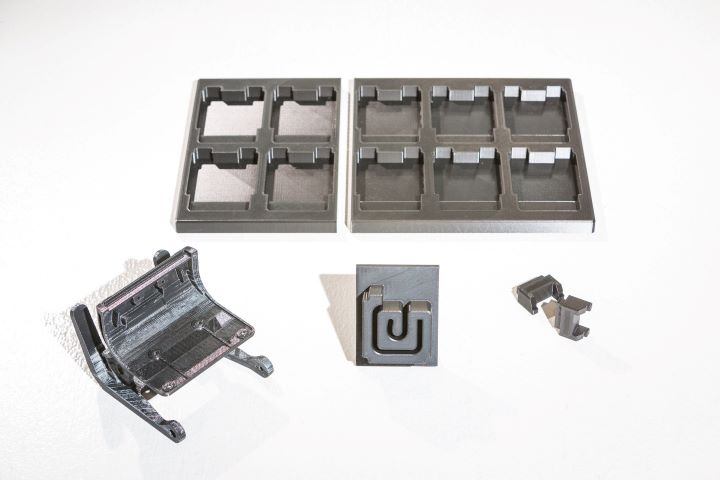Companies, organizations and individuals continue to attempt to lend support to the COVID-19 pandemic supply effort. We will be providing regular updates about these initiatives where necessary in an attempt to ensure that the 3D printing community is aware of what is being done, what can be done and what shouldn’t be done to provide coronavirus aid.
Among the companies tasked by the federal U.S. government to tackle medical supply shortages was General Motors, which was contracted under the Defense Production Act to build 30,000 ventilators. As of June 1, the company—which has struggled as an automaker over the years—delivered the first 6,132, with the rest expected to be delivered by the end of August.
To produce the ventilators, GM leaned heavily on 3D printing. In addition to personal protection equipment, the auto company 3D printed nearly all of the tooling necessary to build the ventilator systems with its partners Ventec Life Systems and Hamilton Medical. Many of these are fixtures that were reverse engineered from Ventec and Hamilton part data and were meant to hold parts in place during assembly. In order to have the 3D printing capacity necessary, GM had 3D printers shipped from its Additive Innovation Lab and Additive Industrialization Center in Warren, Michigan to its manufacturing plant in Kokomo, Indiana.
Dominick Lentine, senior manufacturing engineer of additive applications at GM, said of the technology’s use in ventilator production, “3D printing allows us to make constant, rapid changes to fixtures based on feedback from the assembly teams. We can receive feedback from Hamilton, improve a part and have it flown back to Reno in less than 24 hours.”
SME has published an account of some of the challenges to 3D printing PPE in the current environment, touching on many of the topics that we have already discussed in previous stories and some that we have not. For instance, the post highlights the overabundance of designs now available for producing PPE and how some actually don’t work, while others do. Another issue is the creation of one-size-fits-all designs that may not actually work for every wearer. Material shortages have also been a problem for some efforts to 3D print PPE. Perhaps most importantly, the fear of liability still hangs over all of those involved in the 3D printing of medical devices who may not have the proper facilities, equipment, training and certifications.
Additive software developer Simplify3D has begun publishing a series detailing research dedicated to 3D printing PPE amid the COVID-19 pandemic. Titled “Lessons from the Field,” the work combines experience from Simplify3D engineers who spent hundreds of hours producing PPE equipment and feedback from over 40 organizations that were engaged in similar operations. Every post in the series will cover a different piece of PPE, including 3D model recommendations based on testing and feedback from healthcare professionals, sourcing, print optimization advice, assembly instructions and tips on distribution.
3D printing isn’t the only technology being used to deal with the new normal of life under COVID-19. As with AM, other technologies meant to address the crisis can seem either opportunistic or truly innovative.
As states and municipalities begin to reduce quarantine requirements, businesses operations are attempting to restart with new measures in place to reduce the possibilities of infection. Looking to capitalize on that process, British wearables firm Equivital has developed a social distancing device called eqWave, which alerts workers if they’re within 2 meters of one another. The product uses ultra wide band radio and Bluetooth to detect other eqWaves to provide 360-degree coverage around the wearer, alerting them with an LED light and haptic vibration.
Singapore-based robotics manufacturer Otsaw Digital Pte. has developed what it calls an autonomous disinfection robot. The system, dubbed O-RX, uses UV-C LED technology kill microbes, such as bacteria and COVID-19. The company suggests that, unlike UV-A and UV-B emitting mercury lamps, the machine’s UV-C LED light is safe and non-carcinogenic. Otsaw also claims that the O-RX has a disinfection rate of over 99.999%. Developed in just eight weeks, the O-RX uses a 360-degree camera and LiDAR sensors to allow it to drive automatically and avoid obstacles.
As the pandemic continues to grip the world, we will continue to provide regular updates about what the 3D printing community is doing in response. As always, it is important to keep safety in mind, remain critical about the potential marketing and financial interests behind seemingly good humanitarian efforts from businesses, and to do no harm.
Subscribe to Our Email Newsletter
Stay up-to-date on all the latest news from the 3D printing industry and receive information and offers from third party vendors.
You May Also Like
NSF Awards Kentucky $1M for Advanced Manufacturing
The National Science Foundation has awarded a $1 million grant to the University of Louisville for the Advancing Manufacturing and Building Construction Technologies (NSF AMT) project. This initiative is part...
3D Printing News Briefs, May 11, 2024: 3D Printed Stent, Tower, Sculptures, & More
We’re starting off with medical research in today’s 3D Printing News Briefs, as researchers in Korea used CT images and 3D printing to fabricate an educational simulator for a mastoidectomy....
3D Printing Unpeeled: Wind Turbines, Probiotics and Lenses
TPI Composites, ORNL and Ingersoll Rand are working to make wind turbine tooling segments that can be 18.3 meters long. These elements also include resistive wires that help keep the...
Tethon 3D Releases Cost-effective Bioprinter
Tethon 3D, known for its ceramic-loaded DLP materials, custom resins, and DLP 3D printers, has recently released a bioprinter. Vat polymerization printers like DLP systems have been widely used by...




































